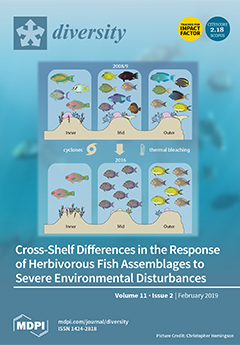The use of natural variation in stable isotope ratios continues to be used in ecological studies without proper validation through laboratory studies. This study tested the effects of temperature, time, and turnover in the scales of juvenile corn snakes (
Elaphe guttata)
[...] Read more.
The use of natural variation in stable isotope ratios continues to be used in ecological studies without proper validation through laboratory studies. This study tested the effects of temperature, time, and turnover in the scales of juvenile corn snakes (
Elaphe guttata) in a controlled, laboratory environment. Snakes were assigned to four treatment groups (24 °C, 27 °C, 30 °C, and freely thermoregulating), and one snake from each group was sacrificed weekly. Scales from each snake were washed, dried, and analyzed for δD and δ
18O at the Stable Isotope Research Facility for Environmental Research at the University of Utah. The effects of temperature on the turnover of tissues was only significant when comparing the thermoregulating group to the pooled treatment groups (24 °C, 27 °C, and 30 °C) in the δ
18O of scales (
p = 0.006). After normalizing data on the δD and δ
18O using percent change for comparison, δ
18O appeared to be turning over at a faster rate than δD as indicated by an analysis of covariance (ANCOVA) test for homogeneity of slopes (F
1,53 = 69.7,
p < 0.001). With further testing of assumptions, a modification of our methods could provide information on the composition of drinking water sources in a species that switches between two isotopically distinct sources, such as during seasonal shifts in habitat or migration, and/or estimates of long-term field metabolic rates based on the turnover of these isotopes.
Full article





